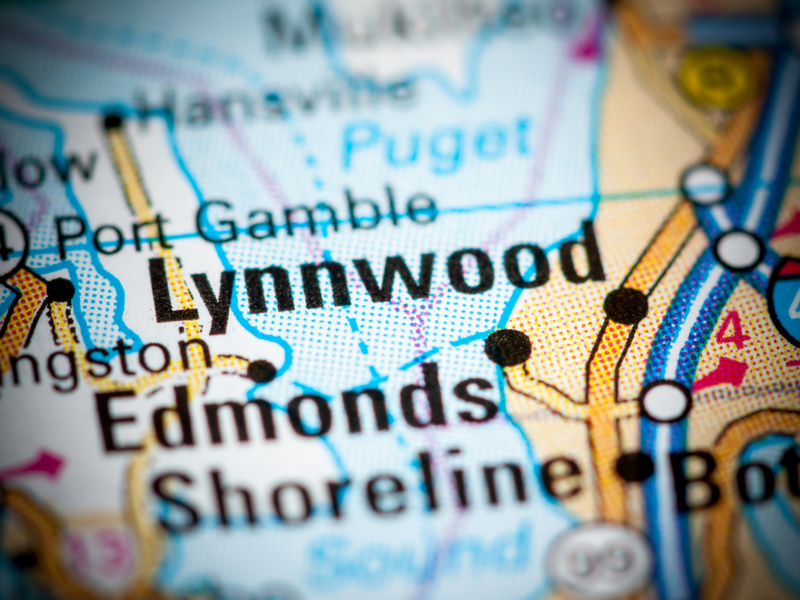
Welcome to Lynnwood
You found the right website if you are searching for homes for sale in Lynnwood, WA. Our website has EVERY Lynnwood home for sale in Washington listed with Northwest MLS (NWMLS).
Lynnwood is a city in Snohomish County, Washington, United States. The city is part of the Seattle metropolitan area and is located 16 miles (26 km) north of Seattle and 13 miles (21 km) south of Everett, near the junction of Interstate 5 and Interstate 405. It is the fourth-largest city in Snohomish County, with a population of 35,836 in the 2010 U.S. census.
Lynnwood is a suburban bedroom community for Seattle, Everett and Bellevue. It has one of the largest concentrations of retailers in the region, anchored by the Alderwood Mall and businesses along major streets. The city also has a community college, a convention center, and a major transit center, located in the developing city center.
Prior to contact with American settlers, the Snohomish tribe of Native Americans used the area of modern-day Lynnwood for summertime activities, including hunting, fishing, berry gathering, and root cultivation. The Snohomish were relocated to the Tulalip reservation, near modern-day Marysville, after the signing of the Treaty of Point Elliott in 1855, opening the area for American settlement.
Brown’s Bay, part of Puget Sound, and modern-day Meadowdale were surveyed by American loggers in 1859. Logging on Brown’s Bay began in 1860, and the first American settlers arrived in the 1880s. Scottish-born stonemason Duncan Hunter became the area’s first white resident in 1889, filing an 80-acre (32 ha) land claim on modern-day 36th Avenue West after moving west from Wisconsin. The claim was inherited by Hunter’s son Basil, who lived on the property until his death in 1982; it was later turned into the city’s Pioneer Park in the late 1980s. Hunter was joined to the east by a claim from William Morrice, a fellow stonemason from Aberdeen, Scotland. Settlers from Pennsylvania homesteaded along Cedar Valley, to the south of Hunter and Morrice, and near Scriber Lake (named for Peter Schreiber) in 1888, leading to the establishment of the area’s first schoolhouse in 1895.
During the early 20th century, the Lynnwood area was gradually logged by private companies and mill operators, leaving behind plots with tree stumps. The arrival of the Seattle–Everett Interurban Railway in 1910 brought reliable transportation to the area, as well as real estate speculators. The Puget Mill Company, then the largest landowner in southern Snohomish County, established the planned community of “Alderwood Manor” in 1917 and marketed the area to urban dwellers wishing to build farms in the countryside. Alderwood Manor, located near an Interurban station, gained streets named for tree species and was divided into 5-to-10-acre (2.0 to 4.0 ha) plots that sold for $200 per acre. A 30-acre (12 ha) “demonstration farm” was built to educate new residents on raising crops and chickens, as well as market the Alderwood Manor plots to “Little Landers”, a nickname for the new residents. Alderwood Manor grew to over 1,463 people and 200,000 hens by 1922, and had electricity and telephone services to most of its residents.
The Puget Mill Company leased out its demonstration farm in 1933 and ceased operations at Alderwood Manor later in the decade, amid declining sales during the Great Depression. At the same time, the opening of the Pacific Highway (modern-day Highway 99) in 1927 and the decline of Interurban service in the 1930s shifted the center of economic growth west near Scriber Lake. Seattle realtor Karl O’Brien filed a plat along Highway 99 at 196th Street Southwest in 1937, naming the development “Lynnwood” after his wife Lynn. Nearby businesses adopted the name during the 1940s, leading to the formal use of “Lynnwood” by the chamber of commerce in 1946, instead of the suggested “West Alderwood”.
Lynnwood gained its first post office in 1948, after a successful lobbying campaign by the Lynnwood Commercial Club to the federal Post Office Department. Throughout the early 1950s, Lynnwood saw slow residential development, in part because of the lack of sewers and other municipal services. Local residents sought to be annexed into Edmonds, but were denied and left to organize their own city. In 1956, a committee to study incorporating Lynnwood as a city was formed, proposing an area of 6.7 square miles (17 km2) and population of 10,744 for the new city. A petition to incorporate was signed by 600 voters and submitted early the following year, proposing a 6-square-mile (16 km2) city; during the early months of 1958, several property owners asked to be removed from the proposal over disinterest in the Lynnwood group. An incorporation measure was put before voters on the November 1958, failing by a narrow margin of 890 to 848 votes.
A second attempt at incorporation, with a revised size of three square miles (7.8 km2) and population of 6,000, was approved by a 2-to-1 margin on April 14, 1959. The successful incorporation was credited in part to the movement of dilapidated homes and structures from the right of way of Interstate 5, a freeway to be built through Alderwood Manor, into the Lynnwood area at the behest of the county government. Realtor Jack Bennett was elected the city’s first mayor, and the city council first met on April 20. The city charter was approved by the county commissioners on April 23, 1959, marking Lynnwood’s official incorporation as a third-class city. Two years after incorporation, the young city was mired in a legal dispute with neighboring Edmonds over the annexation of the Browns Bay area, which was resolved in an out-of-court settlement.
Lynnwood began offering municipal services in its first years, opening a sewage treatment plant, a public park, new streets, and acquiring a water system from the Alderwood Water District. The city began building its 18-acre (7.3 ha) civic center complex in 1969, shortly after the approval of a bond issue to finance the $1.5 million project (equivalent to $8.28 million in 2020 dollars). The civic center, located at 44th Avenue West and 194th Street Southwest, came after a decade in leased facilities scattered around the city center. The first buildings on the campus, including the city hall and public library, opened in 1971. Later expansions to the civic center added a police station, a municipal courthouse, and an indoor recreation center.
The opening of Interstate 5 in 1965 moved the commercial center of Lynnwood east towards Alderwood Manor, which culminated in the proposed construction of a large shopping center in 1968. The 130-acre (53 ha) shopping center, named Alderwood Mall and developed by Allied Stores, was put on hold during the local recession of the early 1970s and was later sold to shopping mall developer Edward J. DeBartolo Sr. in 1976. Alderwood Mall opened on October 4, 1979, sparking a major retail and residential boom in the Lynnwood area in the early 1980s. The Swamp Creek Interchange at Interstate 5 and Interstate 405 was completed in 1984, creating a new regional connection to Alderwood and Lynnwood from the Eastside region of King County.
During the 1980s, Lynnwood gained its first of several office parks, housing high-tech companies expanding from the Eastside and the Canyon Park area of Bothell. Shopping areas developed around Alderwood Mall at the same time, creating the county’s largest retail center, and new housing areas spread out from the city limits of Lynnwood. Despite the development boom of unincorporated areas surrounding Lynnwood, growth within the city itself slowed in the late 1980s and 1990s, attributed to few annexations and slow natural growth.
Lynnwood began developing plans for a “city center” near the Alderwood Mall area in the 1980s. Like other post-war suburbs, Lynnwood developed without a defined central business district and sought to consolidate cultural facilities and high-density development in a manner similar to Downtown Bellevue. In the late 1990s, the Washington State Department of Transportation rebuilt several interchanges on Interstate 5 in Lynnwood, including the construction of a full diamond interchange at 196th Street Southwest costing $80 million. The city opened a $31 million, medium-sized convention center in 2005 to anchor the future city center. The City of Lynnwood formally adopted its City Center Subarea Plan in 2007, outlining plans to re-develop a 300-acre (120 ha) area between Lynnwood Transit Center and Alderwood Mall into a central business district. Development of the city center began in 2015, with the construction of two apartment buildings and a hotel located near the convention center.
According to the United States Census Bureau, the city of Lynnwood has a total area of 7.86 square miles (20.36 km2), of which 7.84 square miles (20.31 km2) is land and 0.02 square miles (0.05 km2) is water. The city is in the southwestern part of Snohomish County in Western Washington, and is considered part of the Seattle metropolitan area. It is at the junction of Interstate 5 and Interstate 405, approximately 16 miles (26 km) north of Seattle, 19 miles (31 km) northwest of Bellevue, and 13 miles (21 km) south of Everett.
Lynnwood’s city limits are roughly defined to south by Mountlake Terrace at 212th Street Southwest and the Interurban Trail; to the west by Edmonds along 76th Avenue West and Olympic View Drive; to the north by the unincorporated Picnic Point-North Lynnwood area, near 164th Street Southwest; and to the east and south by the unincorporated Alderwood Manor, along State Route 525 and Interstate 5. The city’s urban growth area (UGA) includes Alderwood Manor and part of North Lynnwood, extending east to Locust Way and Mill Creek, and north to the Mukilteo UGA at 148th Street Southwest.
Lynnwood is situated 300 to 600 feet (91 to 183 m) on a plateau above Puget Sound, which lies to the city’s west, and consists of several hills and valleys. The city has eighteen identified drainage basins, most of which drain into Swamp Creek or Puget Sound via Lund’s Gulch. Other natural features within Lynnwood include Scriber Lake and Hall Lake. One of the highest hills in the Seattle area is 649-foot (198 m) Lake Serene Hill, near the lake of the same name. The city has extensive views of the Olympic Mountains to the west and the Cascade Mountains to the east.
The main retail and commercial corridor of the city is the “Lynnwood Triangle”, bordered to the east by Interstate 5, to the south by Southwest 196th Street, and to the west by 44th Avenue West. The “Triangle” area has been proposed as the site of a city center for Lynnwood since the 1980s, including planning for a future light rail station and high-density development surrounding it.
As of 2015, Lynnwood has an estimated 19,095 residents who were in the workforce, either employed or unemployed. Only 12 percent of Lynnwood residents work within city limits, while approximately 31 percent commute to Seattle, 9 percent to Everett, 6 percent to Bellevue, and 4 percent to Edmonds. Regional job centers in Downtown Seattle, the Boeing assembly plant near Paine Field in Everett, Downtown Bellevue, and the Microsoft Redmond Campus employ the majority of Lynnwood workers. The average one-way commute for Lynnwood workers in 2015 was approximately 30 minutes; 69 percent of workers drove alone to their workplace, while 12 percent carpooled, and 10 percent used public transit. The largest industry of employment for Lynnwood workers are educational services and health care, with approximately 23 percent, followed by retail (15%), food services (13%), and professional services (12%).
Lynnwood is also a major job center for Snohomish County, with approximately 24,767 jobs in 2012, but only seven percent of workers in Lynnwood live within the city limits. Over 52 percent of workers in Lynnwood reside within Snohomish County, while 9 percent reside in Seattle. The largest industry in Lynnwood is the services sector, with approximately 45 percent of workers, followed by retail (28%) and education (8%). The retail sector, centered around Alderwood Mall, employs 7,000 people and generates 50 percent of the city’s tax revenue. Professional services are concentrated in office parks near Alderwood Mall, comprising 176 buildings with nearly 2.8 million square feet (260,000 m2) of leasable office space. The largest non-retail employers in the city include the Edmonds School District, the city government, and Automatic Data Processing (ADP). Clothing retailer Zumiez and knife manufacturer SOG Specialty Knives are headquartered in Lynnwood.
Public schools in Lynnwood are operated by the Edmonds School District, which also serves the cities of Edmonds, Mountlake Terrace, and Woodway. The district had an enrollment of approximately 20,847 students in 2014 and has 41 schools, of which 16 are located in or around Lynnwood. The Edmonds School District has three high schools located in the Lynnwood area: Lynnwood High School, Meadowdale High School, and Scriber Lake High School. The Lynnwood High School was originally located adjacent to Alderwood Mall, but moved to a new campus a mile (1.6 km) east on North Road in northern Bothell.
Lynnwood is also home to two post-secondary educational institutions. Edmonds College, established in 1967, offers two-year degree programs and other services. It enrolls an average of 11,100 students per quarter. Central Washington University offers four-year bachelor’s degrees in select programs at its Lynnwood campus, which it has shared with Edmonds College since 1975.
Lynnwood also has several private schools, both religious and secular, including The Soundview School, St, Thomas More Parish, and the Brighton School.
The city of Lynnwood has over 350 acres (140 ha) of open space in 19 community and neighborhood parks, as well as 14 miles (23 km) of recreational trails. Part of the open space is set aside as natural conservation areas, including Lund’s Gulch and Scriber Creek. The city also has special recreational facilities, including a municipal golf course, skate park, sports fields, a water park, and a senior center. Central Lynnwood has two major parks: the Scriber Lake nature reserve; and Wilcox Park, the first park in the city, established in 1962. The city government also organizes several regular community events, including the annual Fair on 44th block party, movie screenings, and Shakespeare in the Park.
From 1958 to 2012, Lynnwood and southern Snohomish County were served by a weekly newspaper, The Enterprise. The newspaper was acquired by The Everett Herald in 1996 and renamed to The Weekly Herald in 2011. The Weekly Herald published its final issue on August 29, 2012, due to revenue issues. The city is home to Lynnwood Today, a local blog that was established in March 2010 and is affiliated with The Seattle Times; it was acquired by My Edmonds News, which also owns MLTnews, in 2013.
Lynnwood is part of the Seattle–Tacoma media market, and is served by Seattle-based media outlets including The Seattle Times; broadcast television stations KOMO-TV, KING-TV, KIRO-TV, and KCPQ-TV; and various radio stations. Non-commercial radio station KSER was based in Lynnwood from 1991 to 1994, when it moved to Everett.
Lynnwood opened its municipal library in 1971, contracting services to the regional Sno-Isle Libraries district. The library is the most-visited in the system, which serves most of Snohomish and Island counties, with 504,000 annual visits as of 2012. Lynnwood residents voted in 2006 to be annexed into the Sno-Isle Libraries district, also approving an expansion and modernization that took place in 2013.
Lynnwood has one property listed on the National Register of Historic Places (NRHP): Keeler’s Korner, an automobile service station built in 1927 on Highway 99 at 164th Street Southwest.
The Alderwood Manor Heritage Association was formed in 1991 after the demolition of the oldest home in Alderwood Manor, located east of Lynnwood city limits. The preservation group succeeded in saving other early 20th century homes that were slated for demolition during a highway expansion, moving them to a new, city-owned park. The $1.8 million Heritage Park, opened in 2004, includes the Tudor-style, timber-framed Wickers Building, originally built in 1919; a cottage built for the Alderwood Manor superintendent in 1917; and a restored Interurban trolley car.
The city has two other buildings determined to be eligible for a NRHP listing: the Masonic Temple, built in 1921; and a former schoolhouse built in 1917. Both buildings are located near the city center southwest of Alderwood Mall.
Transportation
Lynnwood is located at the northern junction of Interstate 5 and Interstate 405, the two primary north–south freeways in the Seattle metropolitan area. Interstate 5 continues south to Downtown Seattle, and north to Everett and Vancouver, British Columbia; Interstate 405 continues south to Bellevue and the Eastside, and north to Mukilteo as State Route 525. Lynnwood has two additional state highways: State Route 99, running north to Everett and south to Seattle; and State Route 524, connecting to Edmonds in the west as 196th Street Southwest.
Public transportation in Lynnwood is provided by Community Transit, which serves most of Snohomish County, and Sound Transit, the regional system serving the entire metropolitan area. Most bus service in Lynnwood is concentrated at hubs, including the Lynnwood Transit Center, Ash Way Park and Ride, and Edmonds College. Community Transit operates local routes, including Swift bus rapid transit on State Route 99, and peak-only commuter service to Downtown Seattle and the University of Washington. Sound Transit operates all-day express service from Lynnwood Transit Center and Ash Way Park and Ride to Downtown Seattle and Downtown Bellevue. In 2024, Sound Transit will begin operating Link light rail service to Lynnwood Transit Center, connecting it to Downtown Seattle and the Bellevue–Redmond area. Light rail service is planned to be extended north to Downtown Everett, via Ash Way and Paine Field, in 2036.
Utilities
Electric power in Lynnwood is provided by the Snohomish County Public Utility District (PUD), a consumer-owned public utility that serves all of Snohomish County. Puget Sound Energy provides natural gas service to the city; Lynnwood is also the terminus of a minor gas pipeline operated by the Northwest Pipeline Company.
The Alderwood Water and Wastewater District provides municipal tap water service for Lynnwood, sourced from Everett’s Spada Lake Reservoir. The City of Lynnwood handles sanitary sewer and wastewater treatment; its wastewater treatment plant treats 5 million gallons per day (19,000 m3) that is discharged into Puget Sound. The water district serves the unincorporated areas around Lynnwood and also operates Well Number 5, an artesian well in North Lynnwood that has gained popularity for its quality. The city contracts with Republic Services and Waste Management for garbage, recycling, and yard waste disposal.
Health care
Lynnwood does not have any general hospitals, but is located near the Edmonds branch of Swedish Medical Center, formerly known as Stevens Hospital. The city has several community and specialty clinics operated by regional healthcare providers, including the Community Health Center of Snohomish County, Virginia Mason, and The Everett Clinic.





